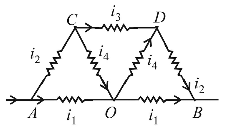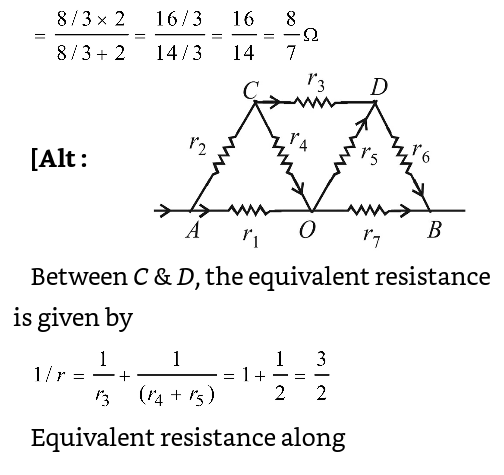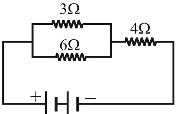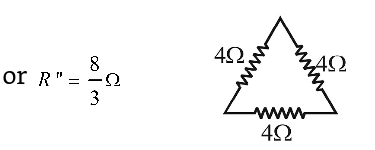Current Electricity
- n equal resistors are first connected in series and then connected in parallel. What is the ratio of the maximum to the minimum resistance ?
-
View Hint View Answer Discuss in Forum
In series, Rs = nR
In parallel, 1 = 1 + 1 + ... n terms Rp R R
∴ Rs/Rp = n² /1 = n²
Correct Option: C
In series, Rs = nR
In parallel, 1 = 1 + 1 + ... n terms Rp R R
∴ Rs/Rp = n² /1 = n²
- In the network shown in the Fig, each resistance is 1Ω. The effective resistance between A and B is

-
View Hint View Answer Discuss in Forum
At A current is distributed and at B currents are collected. Between A and B, the distribution is symmetrical. It has been shown in the figure. It appears that current in AO and OB remains same. At O, current i4 returns back without any change. If we detach O from AB there will not be any change in distribution. Now, CO & OD will be in series hence its total resistance = 2Ω
It is in parallel with CD, so, equivalent resistance = 2 x 1 = 2 Ω 2 + 1 3
This equivalent resistance is in series with AC & DB, so, total resistance= 2 + 1 + = 8 Ω 3 3 
Now 8/3 Ω is parallel to AB, that is, 2Ω, so total resistance
ABCD = 1 + 2 + 1 = 8 Ω 3 3 
Correct Option: D
At A current is distributed and at B currents are collected. Between A and B, the distribution is symmetrical. It has been shown in the figure. It appears that current in AO and OB remains same. At O, current i4 returns back without any change. If we detach O from AB there will not be any change in distribution. Now, CO & OD will be in series hence its total resistance = 2Ω
It is in parallel with CD, so, equivalent resistance = 2 x 1 = 2 Ω 2 + 1 3
This equivalent resistance is in series with AC & DB, so, total resistance= 2 + 1 + = 8 Ω 3 3 
Now 8/3 Ω is parallel to AB, that is, 2Ω, so total resistance
ABCD = 1 + 2 + 1 = 8 Ω 3 3 
- You are given several identical resistances each of value R = 10Ω and each capable of carrying a maximum current of one ampere. It is required to make a suitable combination of these resistances of 5Ω which can carry a current of 4 ampere. The minimum number of resistances of the type R that will be required for this job is
-
View Hint View Answer Discuss in Forum
To carry a current of 4 ampere, we need four paths, each carrying a current of one ampere. Let r be the resistance of each path. These are connected in parallel. Hence, their equivalent resistance will be r/4. According to the given problem
r = 5 or r = 20 Ω 4
For this propose two resistances should be connected. There are four such combinations. Hence, the total number of resistance = 4 × 2 = 8.
Correct Option: C
To carry a current of 4 ampere, we need four paths, each carrying a current of one ampere. Let r be the resistance of each path. These are connected in parallel. Hence, their equivalent resistance will be r/4. According to the given problem
r = 5 or r = 20 Ω 4
For this propose two resistances should be connected. There are four such combinations. Hence, the total number of resistance = 4 × 2 = 8.
- Current through 3 Ω resistor is
 0.8 amp., then potential drop through 4Ω resistor is
0.8 amp., then potential drop through 4Ω resistor is
-
View Hint View Answer Discuss in Forum
Voltage across 3 Ω resistance = 3 × 0.8 = 2.4V
This voltage is the same across 6 Ω resistance.
Hence current through this resistancei = V = 2.4 = 0.4 amp R 6
Total current in the circuit = 0.8 + 0.4 = 1.2 amp
Voltage across 4 Ω resistance = 4 × 1.2 = 4.8 volts
Correct Option: C
Voltage across 3 Ω resistance = 3 × 0.8 = 2.4V
This voltage is the same across 6 Ω resistance.
Hence current through this resistancei = V = 2.4 = 0.4 amp R 6
Total current in the circuit = 0.8 + 0.4 = 1.2 amp
Voltage across 4 Ω resistance = 4 × 1.2 = 4.8 volts
- Three resistances each of 4 Ω are connected to form a triangle. The resistance between any two terminals is
-
View Hint View Answer Discuss in Forum
The two resistances are connected in series and the resultant is connected in parallel with the third resistance.
∴ R' = 4Ω + 4Ω = 8Ω and 1 = 1 + 1 = 3 R" 8 4 8 
Correct Option: D
The two resistances are connected in series and the resultant is connected in parallel with the third resistance.
∴ R' = 4Ω + 4Ω = 8Ω and 1 = 1 + 1 = 3 R" 8 4 8 

